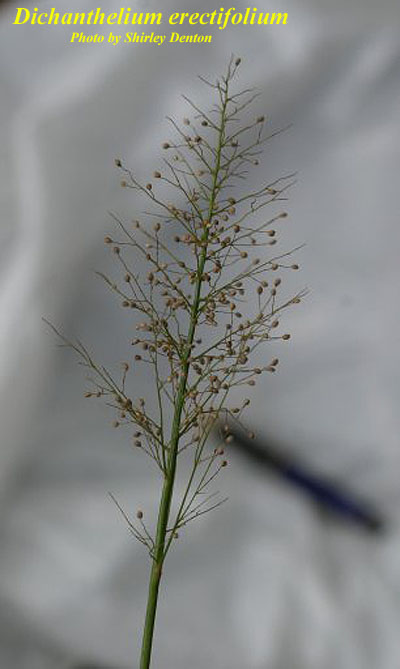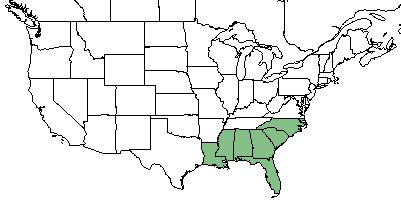Difference between revisions of "Dichanthelium erectifolium"
(→Distribution) |
|||
| Line 28: | Line 28: | ||
==Distribution== | ==Distribution== | ||
| − | ''D. erectifolium'' can occur from Louisiana to North Carolina. However, it is mostly found in Florida <ref name= "USDA"> USDA Plants Database: https://plants.usda.gov/core/profile?symbol=CEAM USDA Plant Database</ref>. | + | ''D. erectifolium'' can occur from Louisiana to North Carolina. However, it is mostly found in Florida<ref name= "USDA"> USDA Plants Database: https://plants.usda.gov/core/profile?symbol=CEAM USDA Plant Database</ref> with disjunct populations in western Cuba.<ref>Sorrie, B. A. and A. S. Weakley 2001. Coastal Plain valcular plant endemics: Phytogeographic patterns. Castanea 66: 50-82.</ref> |
==Ecology== | ==Ecology== | ||
Revision as of 13:31, 15 June 2021
Common names: erectleaf panicgrass
| Dichanthelium erectifolium | |
|---|---|

| |
| Photo by the Atlas of Florida Plants Database | |
| Scientific classification | |
| Kingdom: | Plantae |
| Division: | Magnoliophyta - Flowering plants |
| Class: | Liliopsida - Moncots |
| Order: | Cyperales |
| Family: | Poaceae |
| Genus: | Dichanthelium |
| Species: | D. erectifolium |
| Binomial name | |
| Dichanthelium erectifolium (Nash) Gould | |

| |
| Natural range of Dichanthelium erectifolium from USDA NRCS Plants Database. | |
Contents
Taxonomic Notes
Synonyms: Panicum erectifloium (Nash).[1]
Varieties: none.[1]
Description
D. erectifolium is a perennial gramioid of the Poaceae family that is native to North America. [2]
Distribution
D. erectifolium can occur from Louisiana to North Carolina. However, it is mostly found in Florida[2] with disjunct populations in western Cuba.[3]
Ecology
Habitat
This species has often been found in sand and sandy-loam soils at bog margins and Cypress depressions [4]. It can also be found in habitats such as limestone ponds and pine savannas [5].
Associated species: this species has been frequently found with species of Heypericum and Xyris, specifically Hypericum brachyphyllum and Xyris elliottii. Other associated species are Sabatia bartramii, Rhyncospora spp., Juncus abortivus, Scleria reticularis, Sagittaria isoetiformis, Lycopodium appressum, Cyperus lecontei, Eleocharis spp., Platanthera nivea, and D.scabriusculum [4].
Dichanthelium erectifolim is an indicator species for the Peninsula Savannas community type as described in Carr et al. (2010).[6]
Phenology
D. erectifolium has been recorded blooming in April [7] and August [4]. It has been record to be fruiting from spring to late fall [4].
Fire ecology
Wetland habitats that have recently been subject to fire are ideal habitats for D. erectifolium.[8]
Conservation, cultivation, and restoration
Cultural use
Photo Gallery
References and notes
- ↑ 1.0 1.1 Weakley, A.S. 2015. Flora of the southern and mid-atlantic states. Working Draft of 21 May 2015. University of North Carolina at Chapel Hill, Chapel Hill, North Carolina.
- ↑ 2.0 2.1 USDA Plant Database Cite error: Invalid
<ref>tag; name "USDA" defined multiple times with different content - ↑ Sorrie, B. A. and A. S. Weakley 2001. Coastal Plain valcular plant endemics: Phytogeographic patterns. Castanea 66: 50-82.
- ↑ 4.0 4.1 4.2 4.3 Florida State University Robert K. Godfrey Herbarium database. URL: http://herbarium.bio.fsu.edu. Last accessed: May 2018. Collectors: Robert K. Godfrey, Robert Kral, H. Kurz, Loran C. Anderson, Cecil R. Slaughter, Angus Gholson, Wilson Baker, Sidney McDaniel, William Lindsey, P.L. Redfearn, Steve L. Orzell, Edwin L. Bridges, and Lisa Keppner. States and Counties: Florida: Bay, Calhoun, Escambia, Flagler, Franklin, Gulf, Jackson, Lake, Leon, Liberty, Martin, Nassau, Okaloosa, Palm Beach, St. Lucie, Wakulla, and Washington. Georgia: Thomas. Louisiana: Union.
- ↑ Weakley, A. S. (2015). Flora of the Southern and Mid-Atlantic States. Chapel Hill, NC, University of North Carolina Herbarium.
- ↑ Carr, S.C., K.M. Robertson, and R.K. Peet. 2010. A vegetation classification of fire-dependent pinelands of Florida. Castanea 75:153-189.
- ↑ Nelson, G. PanFlora: Plant data for the eastern United States with emphasis on the Southeastern Coastal Plains, Florida, and the Florida Panhandle. www.gilnelson.com/PanFlora/ Accessed: 21 MAY 2018
- ↑ Observation by Pierson Hill in Southwestern Apalachicola NF, February 14, 2017, posted to Florida Flora and Ecosystematics Facebook Group.